10 Eye-Catching Flower Bed Ideas to Enhance Your Home’s Curb Appeal
1. Multi-Level Terraced Flower Beds
Transform your front yard with multi-level terraced flower beds that add dimension and visual interest. These structured beds work particularly well on sloped properties, turning challenging terrain into a stunning industry feature. Use stone, brick, or wood retaining walls to create different planting zones, and fill each level with complementary plants of varying heights. This approach not only controls erosion but also creates a dramatic landscaping effect that draws the eye upward.
2. Curved Border Flower Beds
Replace straight-lined flower beds with graceful curves that soften your home’s façade and create a more natural, welcoming appearance. Curved borders add movement and flow to your industry, guiding visitors’ eyes toward your entrance. Define these organic shapes with edging materials like stone, metal, or brick, then fill with a mixture of perennials and annuals for year-round interest. The gentle flowing lines work with nearly any architectural style and create more planting space than traditional rectangular beds.
3. Cottage Garden Flower Beds
Capture the charm of English countryside with a cottage garden flower bed that brings a relaxed, romantic feel to your home’s entrance. Plant a seemingly random but carefully curated mix of flowering perennials like delphiniums, hollyhocks, and foxgloves alongside fragrant herbs and old-fashioned roses. Allow plants to spill slightly over walkways and grow in casual abundance. This style works beautifully with traditional homes and brings an established, timeless quality to newer properties.
4. Monochromatic Color Scheme Flower Beds
Create sophisticated visual impact with a monochromatic flower bed featuring various plants in different shades of a single color. Choose plants with varying heights, textures, and bloom times but keep the color palette consistent—whether cool blues, vibrant reds, or calming whites. This approach creates a cohesive, designer look that appears thoughtfully planned rather than haphazard. Add silver-leaved plants or variegated foliage for contrast within your chosen color scheme.
5. Native Plant Flower Beds
Design an eco-friendly flower bed using plants native to your region for a industry that thrives with minimal maintenance. Native plants are naturally adapted to your local climate and soil conditions, requiring less water, fertilizer, and pest control once established. They also support local pollinators and wildlife, adding movement and life to your garden. Research plants indigenous to your exact area and arrange them in naturalistic groupings that mimic how they grow in the wild.
6. Four-Season Interest Flower Beds
Ensure your front yard looks spectacular year-round with a carefully planned flower bed that offers visual interest in every season. Combine spring-flowering bulbs, summer perennials, fall-colored shrubs, and winter-interesting plants with distinctive bark, berries, or evergreen foliage. Include structural elements like ornamental grasses that provide movement in summer and architectural interest in winter. This approach ensures your home’s curb appeal never fades, regardless of the season.
7. Tropical-Inspired Flower Beds
Create a lush, exotic oasis with bold, tropical-inspired flower beds that make a dramatic statement. Even in non-tropical climates, you can achieve this look with plants like cannas, elephant ears, caladiums, and bold-leaved hostas. Add height with ornamental bananas or tall grasses, and incorporate vibrant flowers like hibiscus or crocosmia for splashes of color. This style works particularly well with contemporary or mid-century modern homes and creates an unexpected, vacation-like ambiance.
8. Symmetrical Formal Flower Beds
Enhance traditional or colonial-style homes with symmetrical formal flower beds that create a sense of order and elegance. Design matching beds on either side of your entrance walkway, filled with neatly trimmed boxwood hedges, classic roses, or precisely spaced annual displays. This timeless approach emphasizes architectural features and creates a stately, refined appearance. Add topiaries or small ornamental trees in matching containers to further enhance the symmetrical effect.
9. Succulent and Rock Garden Flower Beds
Create a water-wise, low-maintenance front yard with drought-tolerant succulent and rock garden beds. Combine various succulents like sedums, echeverias, and agaves with ornamental grasses and drought-resistant perennials. Incorporate decorative rocks, pebbles, and boulders for texture and year-round structure. This style works exceptionally well in arid climates or areas with water restrictions and provides a contemporary, sustainable alternative to traditional flower beds.
10. Raised Flower Bed Borders
Frame your home with raised flower bed borders that add architectural interest while improving growing conditions. Build raised beds using materials that complement your home’s exterior—whether brick, stone, concrete blocks, or cedar boards. The elevated planting areas improve drainage, prevent soil compaction, and make maintenance easier while creating a defined edge between lawn and garden areas. Fill with a mixture of shrubs, perennials, and seasonal color for a polished, professional look that enhances your home’s overall curb appeal.
Creating a Colorful Welcome: Classic Flower Bed Designs for Your Front Yard
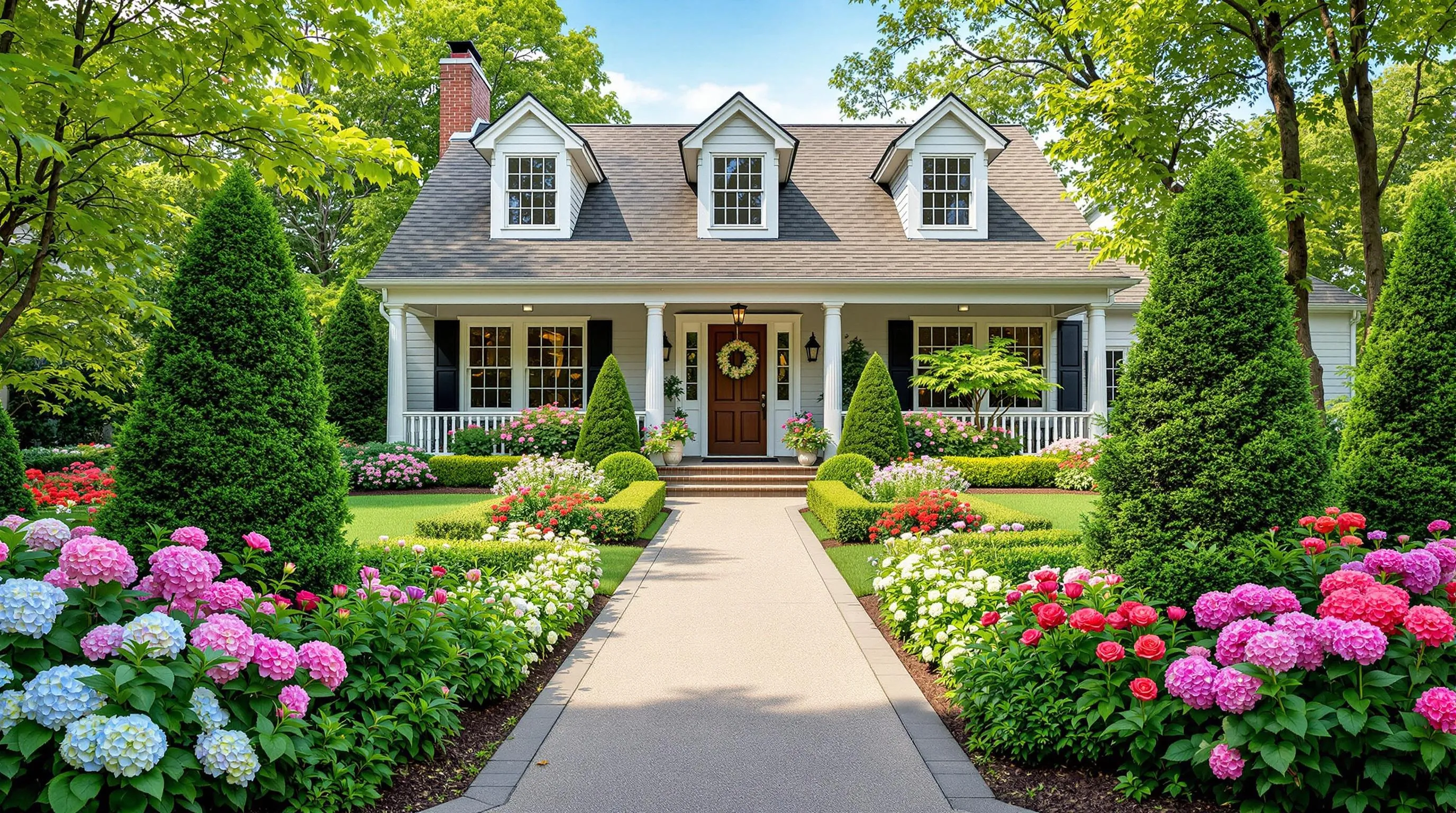
Symmetrical Arrangements for Traditional Homes
Symmetrical flower beds create an elegant, balanced look that perfectly complements traditional home architecture. Start by placing matching plantings on either side of your walkway or entrance for instant visual impact. Choose evergreen shrubs like boxwoods or dwarf arborvitae as anchor plants, then add layers of flowering perennials such as hydrangeas, roses, or peonies for seasonal color. For maximum curb appeal, incorporate classic edging materials like brick, stone, or neatly trimmed hedges to define your beds clearly. This orderly approach creates a formal, welcoming entrance that enhances your home’s architectural style while providing a timeless foundation for your landscaping.
Layered Plantings with Varying Heights
Create ever-changing visual interest in your front yard by designing flower beds with carefully planned height variations. Position taller plants like ornamental grasses, coneflowers, or small flowering shrubs toward the back of the bed (or center for island beds) to serve as an attractive backdrop. Add mid-height plants such as salvias, coreopsis, or daylilies in the middle section, then finish with low-growing options like creeping phlox, alyssum, or sedum along the edges. This three-tier approach ensures every plant remains visible while creating a lush, professional look. For best results, stagger your plantings rather than placing them in straight rows, allowing the eye to move naturally through your garden while maintaining clear sightlines to your home’s entrance.
Seasonal Splendor: Year-Round Flower Bed Planning
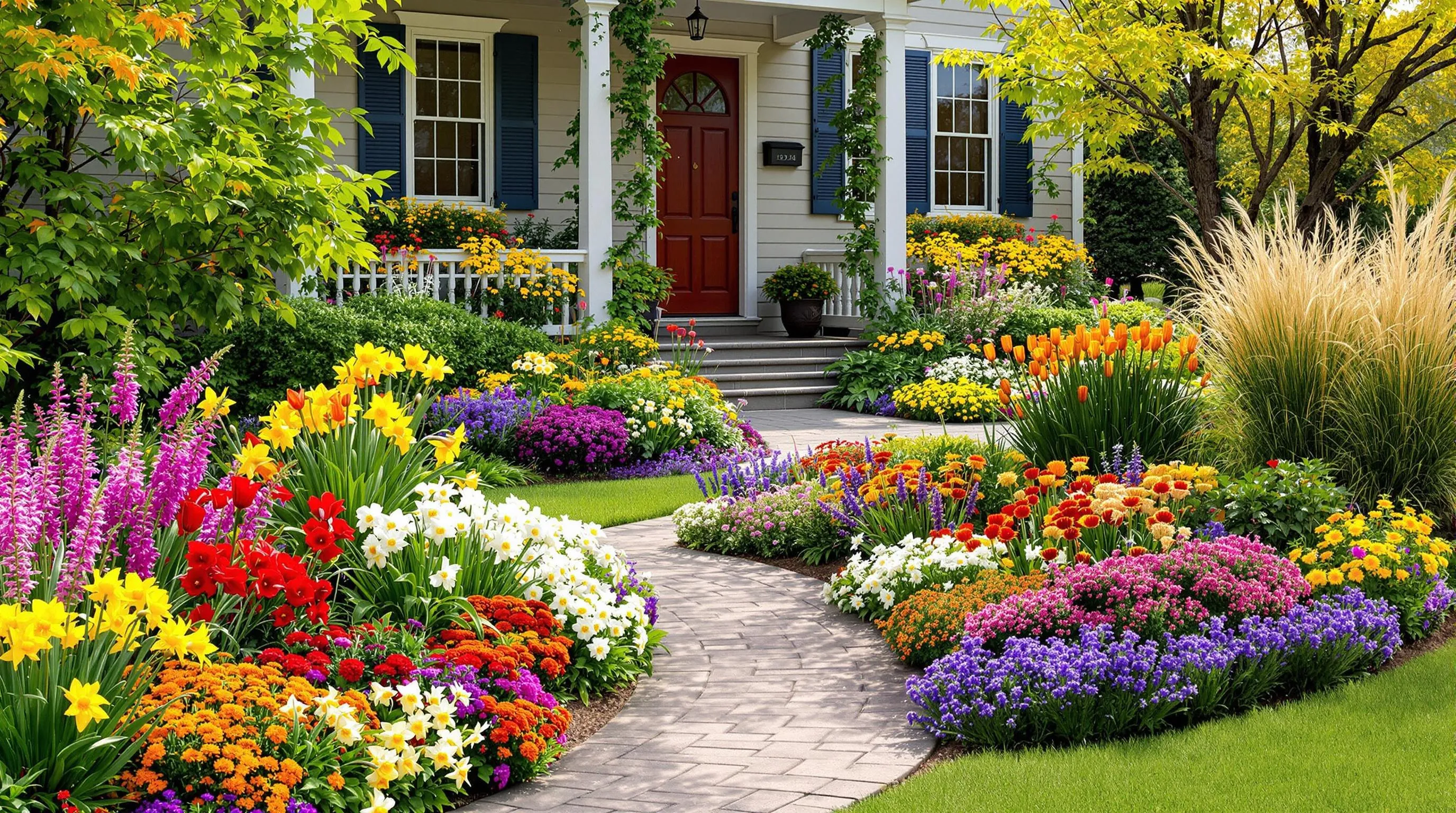
Creating front yard flower beds that look stunning in every season requires thoughtful planning and strategic plant selection. A well-designed year-round garden ensures your home maintains its curb appeal through changing seasons, giving you continuous enjoyment and visual interest.
Spring Bulb Displays That Make a Statement
Spring bulbs create dramatic first impressions after winter’s dormancy. Plant daffodils, tulips, and crocuses in autumn, placing them in clusters of 7-12 bulbs for maximum impact rather than straight lines. Layer bulbs at different depths—plant tulips 6-8 inches deep, daffodils 3-6 inches, and crocuses just 2-3 inches below the surface—to create a succession of blooms from early to late spring. Complement these with early-flowering perennials like hellebores and pulmonaria to extend the display period. For front yard impact, choose bold color combinations such as purple and yellow or red and white that are visible from the street and announce spring’s arrival to passersby.
Summer-to-Fall Transition Gardens
Bridge the summer-fall gap with plants that maintain visual interest through changing seasons. Select perennials like black-eyed Susans, coneflowers, and sedum that begin blooming in midsummer and continue into autumn. Incorporate ornamental grasses such as fountain grass or switchgrass that develop beautiful seed heads and turn golden as temperatures drop. Add late-blooming plants like asters, goldenrod, and Japanese anemones that reach their peak as summer flowers fade. For continuous color, include plants with changing foliage like oakleaf hydrangea or sumac that transform from green to vibrant orange-red. This thoughtful combination ensures your front flower beds remain vibrant during the critical transition months when many gardens lose their appeal.
Low-Maintenance Flower Bed Solutions for Busy Homeowners
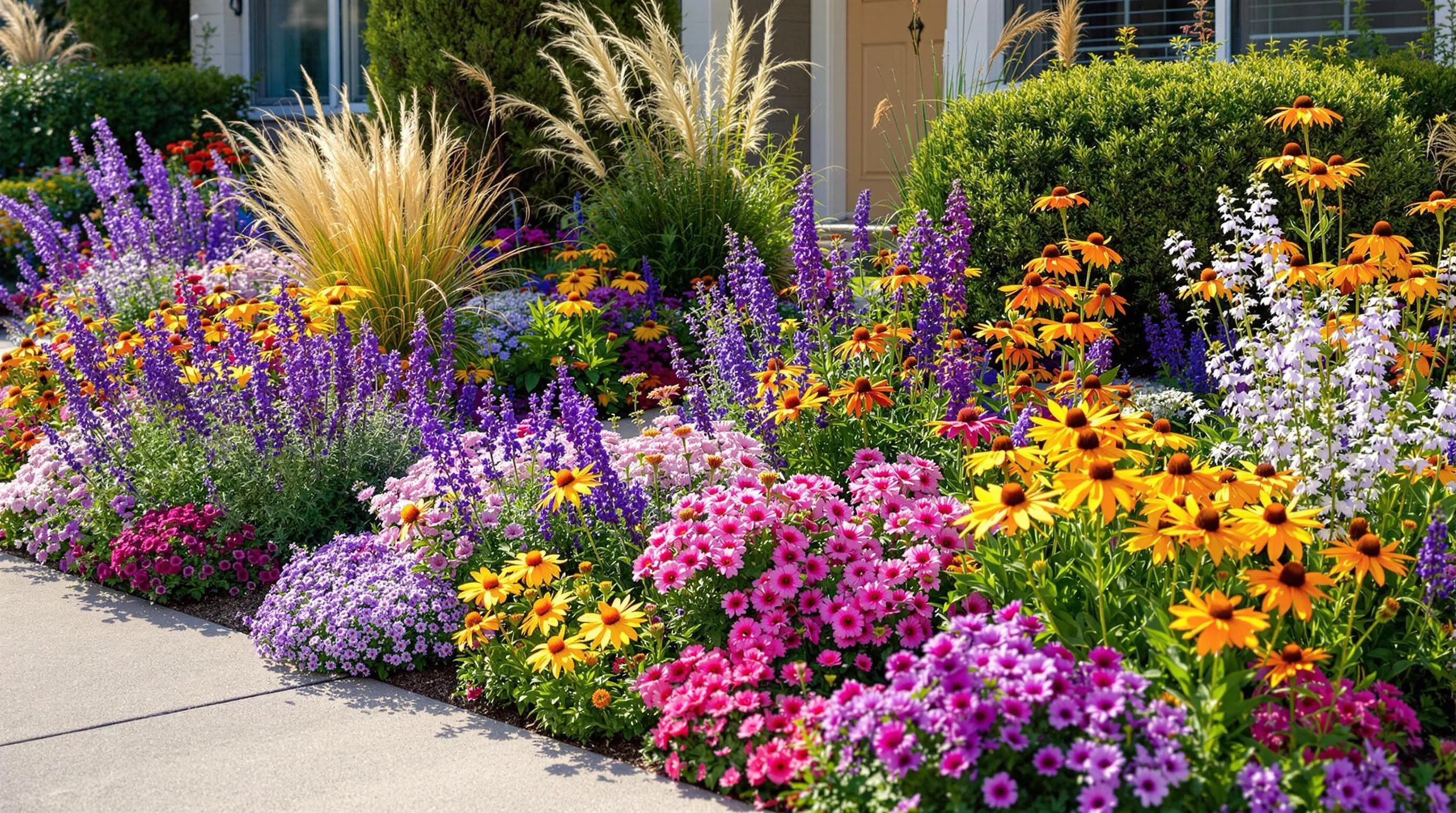
Beautifying your front yard doesn’t have to consume your weekends. These low-maintenance flower bed ideas deliver maximum curb appeal with minimal upkeep, perfect for homeowners with packed schedules.
Drought-Resistant Perennial Combinations
Create stunning, water-wise flower beds by combining drought-resistant perennials that thrive with minimal irrigation. Plant purple coneflowers, black-eyed Susans, and Russian sage for a colorful mix that returns year after year without constant watering. Ornamental grasses like feather reed grass or blue fescue add movement and texture while requiring almost no maintenance. Include Mediterranean herbs such as lavender and rosemary for fragrance and culinary benefits. These plants establish deep root systems after the first year, reducing watering needs to occasional deep soakings during extreme dry spells. Group plants with similar water requirements together to maximize efficiency and prevent overwatering sensitive varieties.
Time-Saving Design Strategies
Carry out smart design strategies to slash maintenance hours while maintaining visual impact. Install quality industry fabric beneath 2-3 inches of mulch to dramatically reduce weeding time and conserve soil moisture. Choose slow-growing shrubs like dwarf ninebark or compact hydrangeas as anchor plants that need pruning just once annually. Create defined edges with permanent materials such as steel edging, decorative stone, or brick to eliminate constant edge maintenance and prevent grass invasion. Incorporate automated drip irrigation systems with timers to deliver precise amounts of water directly to plant roots, cutting watering time and reducing water waste. Select self-cleaning flowers like daylilies and coreopsis that don’t require deadheading to continue blooming throughout the season.
Border Beauty: Defining Your Walkway with Stunning Flower Beds
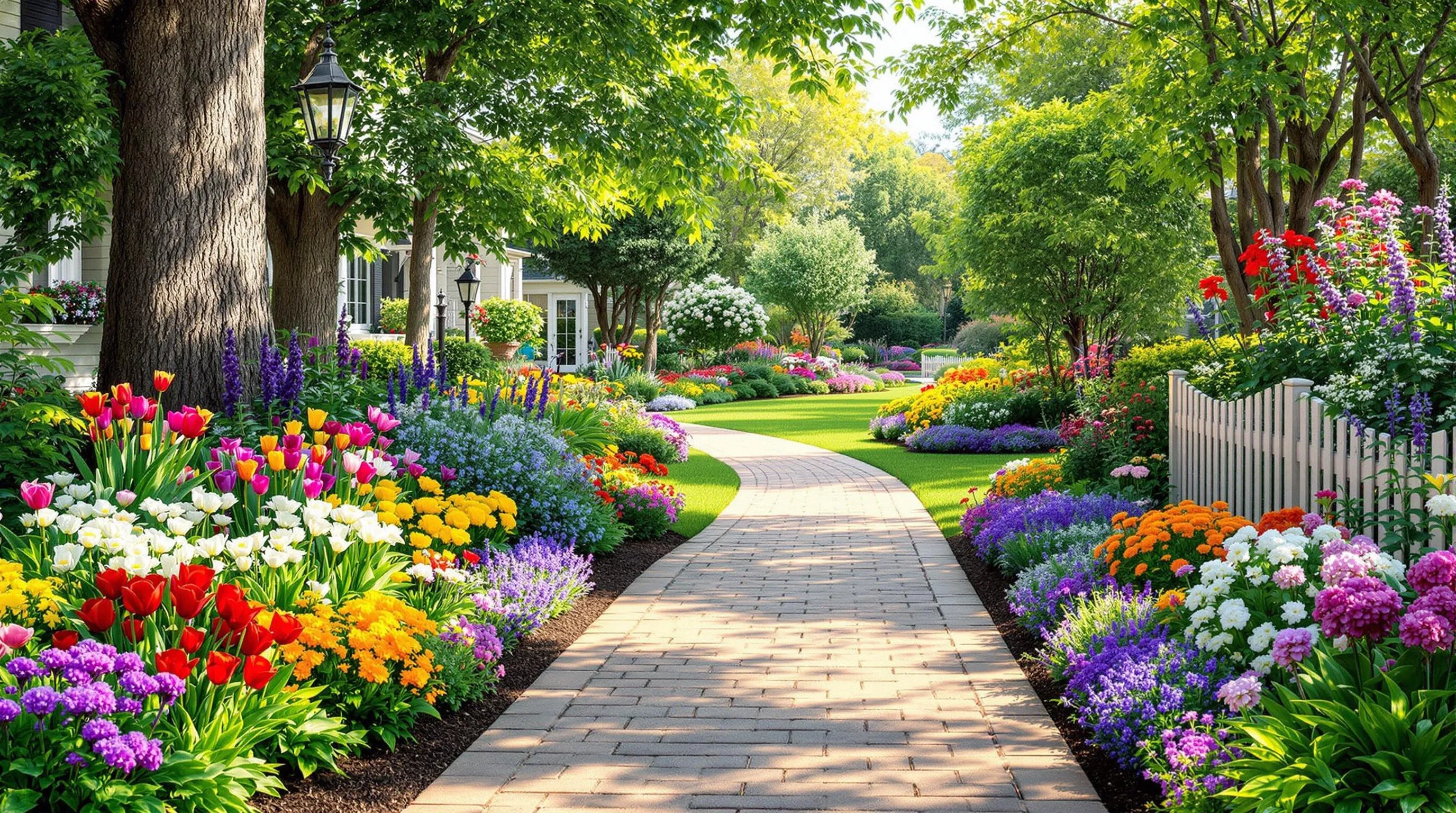
Transform your home’s entrance by lining your walkway with captivating flower beds that guide visitors to your door while making a striking first impression. Well-designed pathway borders not only define your walkway but also add character and charm to your property’s frontage.
Continuous Blooming Pathways
Create a walkway that dazzles year-round by planning for continuous blooms along your path borders. Start with early spring bulbs like grape hyacinths and snowdrops, then transition to mid-season performers such as salvias and coreopsis for summer color. Include late-blooming plants like asters, sedums, and Japanese anemones to carry the display into fall. Mix in evergreen ground covers like creeping phlox or thyme between taller plants to fill gaps and provide foliage interest when flowers aren’t present. This strategic planting ensures your walkway remains vibrant and inviting regardless of the season, creating a ever-changing entrance that evolves throughout the year.
Fragrant Plants for Entryway Gardens
Enhance your walkway experience by incorporating fragrant plants that release delightful scents as visitors approach your home. Position aromatic herbs like lavender, rosemary, and thyme along the edges where they’ll release their fragrance when brushed against. For evening enjoyment, include night-blooming varieties such as moonflower, evening primrose, or nicotiana that release their perfume after sunset. Classic fragrant perennials like peonies, lilacs, and roses can serve as focal points, while low-growing sweet alyssum provides continuous subtle scent all season long. This sensory addition transforms a simple walkway into an immersive experience that engages multiple senses and creates lasting impressions for everyone who visits your home.
Modern Minimalist Approaches to Front Yard Flower Beds
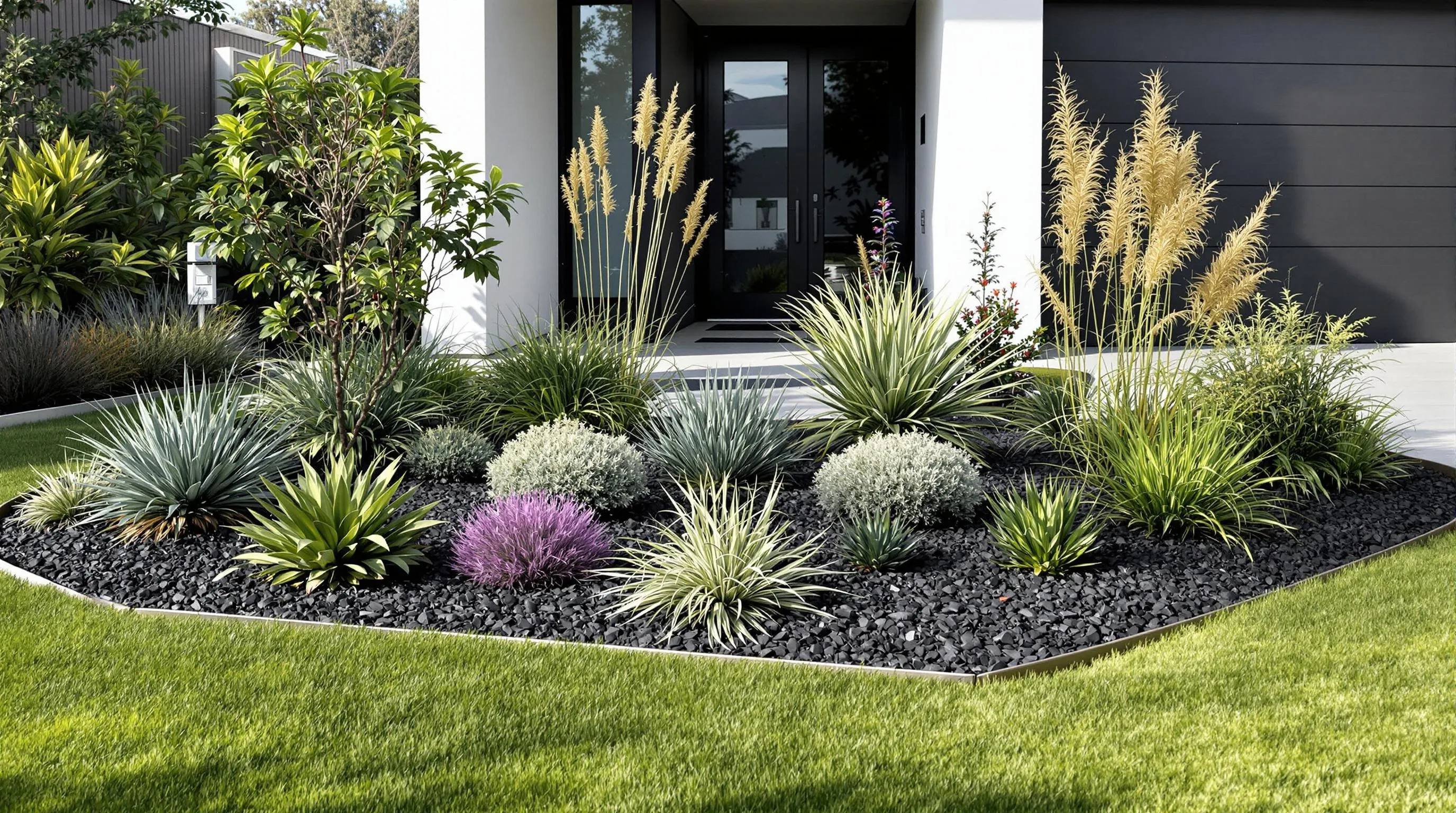
Modern minimalist flower beds offer a sleek, contemporary alternative to traditional garden designs. These simplified landscapes create visual impact through restraint rather than abundance, making them perfect for contemporary home styles.
Architectural Plants and Clean Lines
Architectural plants form the backbone of minimalist flower beds, creating dramatic structure with their distinctive shapes. Choose specimens like New Zealand flax, agave, or ornamental grasses that provide strong silhouettes against your home’s façade. Arrange these statement plants with ample spacing to highlight their unique forms—try placing them in groups of three or five for a deliberate, designed look. Define your beds with straight edges or gentle curves using steel edging, concrete borders, or cut stone for that crisp, contemporary finish. Complement these structured elements with a layer of monochromatic mulch like black volcanic rock or white marble chips to enhance the modern aesthetic while suppressing weeds.
Monochromatic Color Schemes
Embrace the power of simplicity with monochromatic flower beds that deliver maximum impact through color restraint. A single-color palette—whether it’s all white blooms against dark foliage, various shades of blue, or a gradient of purples—creates a sophisticated, cohesive look that’s visually striking without being busy. White gardens particularly enhance modern homes, creating a stunning nighttime display as the blooms appear to glow in moonlight or industry lighting. For texture and interest within your monochrome scheme, incorporate plants with varying heights, leaf shapes, and bloom forms. Consider silvery artemisia paired with white echinacea and snow-in-summer for a white garden, or mix lavender, salvia, and Russian sage for a soothing purple display. This restrained approach reinforces the minimalist philosophy that less truly can be more.
Working with Challenging Spaces: Flower Bed Ideas for Unique Front Yards
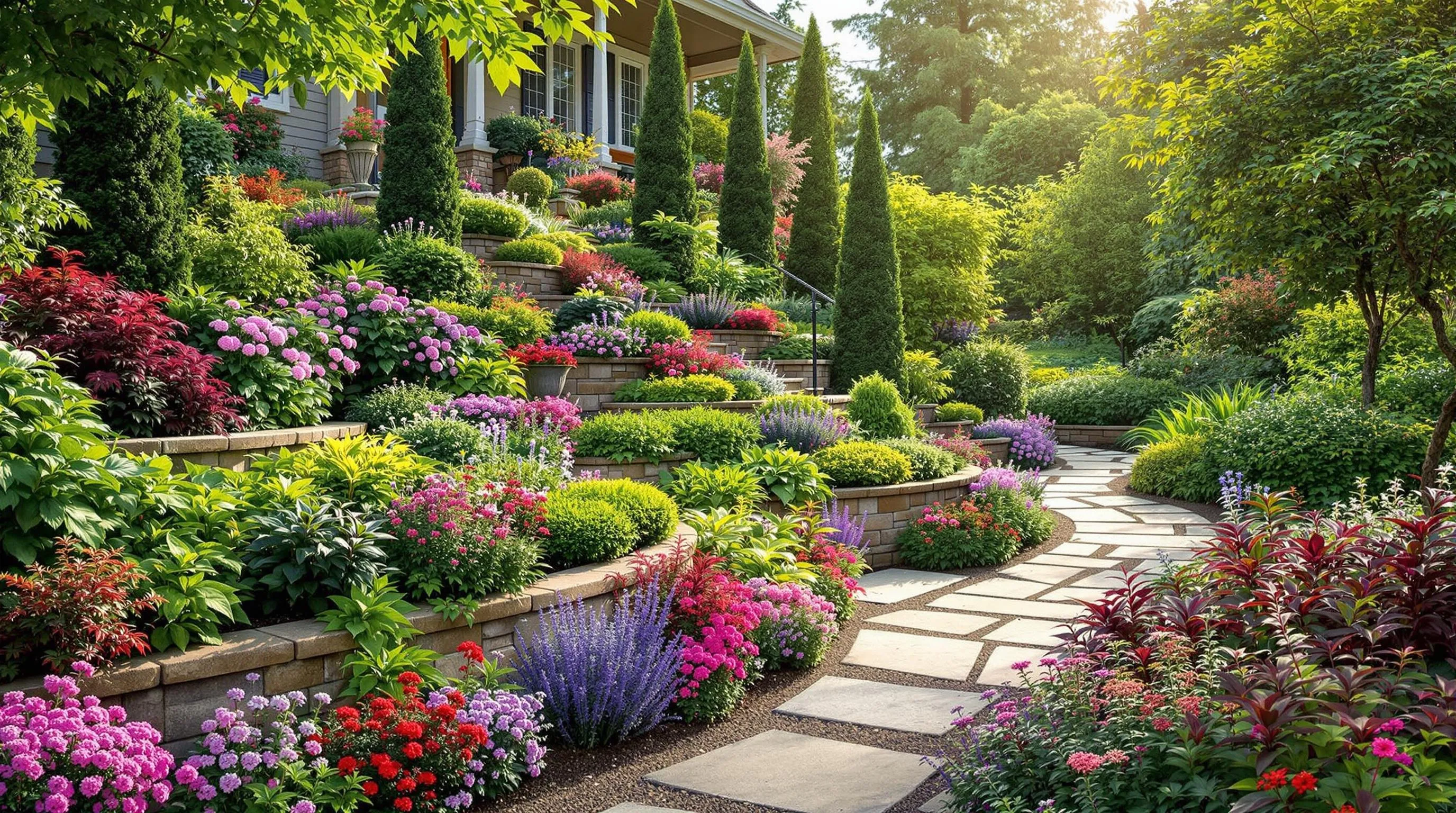
Not every front yard comes with perfect conditions for gardening. Many homeowners face challenges like steep slopes, limited sunlight, or awkward layouts. These unique characteristics don’t have to limit your landscaping potential—they can actually inspire creative flower bed answers that turn problem areas into stunning focal points.
Answers for Sloped Front Yards
Sloped front yards offer exciting opportunities for dramatic landscaping that flat properties simply can’t achieve. Transform your challenging terrain with terraced flower beds that prevent erosion while creating visual interest. Install retaining walls using natural stone, timber, or concrete blocks to create flat planting areas at different elevations. For gentle slopes, try serpentine flower beds that follow the natural contour of the land, using ground covers like creeping phlox or sedum to stabilize soil between focal plants. Incorporate dwarf evergreens on the upper portions to anchor your design year-round, while drought-tolerant plants like Russian sage and yarrow thrive on the typically drier upper sections. For steeper inclines, stepping stones or a rustic stairway bordered with cascading plants like trailing verbena or wave petunias create a functional yet beautiful transition between levels.
Shade-Loving Arrangements for North-Facing Homes
North-facing front yards present unique lighting challenges, but they’re perfect for creating lush, woodland-inspired flower beds. Embrace the shade with stunning foliage plants that add texture and visual interest even without abundant blooms. Incorporate varying heights of hostas with their impressive variety of colors and patterns, from blue-green to variegated cream and green. Add structure with Japanese forest grass, ferns, and coral bells (Heuchera) that come in shades from deep burgundy to lime green. For flowering options that thrive in low light, include astilbe with its feathery plumes, bleeding hearts with their distinctive heart-shaped blooms, and Japanese anemones that offer late-season color. Introduce spring interest with bulbs like snowdrops and lily-of-the-valley before tree canopies fill in. Enhance your shade garden with strategic hardscaping elements like light-colored stones or a small water feature that reflects available light and brightens the space naturally.
Eco-Friendly Flower Beds That Support Local Wildlife

Creating eco-friendly flower beds isn’t just beautiful—it’s a powerful way to support your local network while improving your home’s curb appeal. These environmentally conscious designs transform your front yard into a vibrant habitat that attracts and sustains wildlife while requiring fewer resources to maintain.
Pollinator Gardens That Buzz with Life
Transform your front yard into a buzzing oasis by designing flower beds specifically for pollinators. Plant nectar-rich flowers like coneflowers, bee balm, and butterfly bush to attract honeybees, butterflies, and hummingbirds. Create a succession of blooms from early spring through late fall to provide continuous food sources—early spring bulbs like crocus followed by summer perennials and late-blooming asters. Include shallow water features such as bird baths with pebbles where insects can safely land and drink. Avoid using pesticides in your pollinator garden, as these chemicals harm the very creatures you’re trying to attract. Cluster similar flowers in groups of at least three plants to create visible “landing pads” that make it easier for pollinators to find and feed on blooms.
Native Plant Selections for Sustainable Beauty
Incorporate native plants into your front yard flower beds to create a low-maintenance industry that thrives naturally in your region. Native plants have evolved to flourish in your local soil and climate conditions, requiring up to 80% less water than non-native species once established. Choose regional wildflowers like black-eyed Susans in the East, California poppies in the West, or coreopsis in the South to create spectacular seasonal displays without chemical fertilizers. Mix in native grasses such as little bluestem or switchgrass to add texture and winter interest. These indigenous plants provide essential habitat for local birds, butterflies, and beneficial insects that have co-evolved with these species over thousands of years. By selecting native plants adapted to your exact growing zone, you’ll create a resilient industry that connects your property to the broader regional network while reducing maintenance demands.
Budget-Friendly Flower Bed Transformations

Creating stunning flower beds doesn’t require very costly. With some creativity and smart planning, you can transform your front yard on a budget while still achieving maximum curb appeal.
DIY Edging Options That Make a Difference
Edging instantly elevates your flower beds by creating clean, defined borders that separate your blooms from the lawn. Repurpose bricks from old projects by arranging them in a soldier course (standing upright) or flat pattern for a classic look. Collect flat stones from your property or local creek beds to create a natural, rustic edge that costs nothing but time. Transform wine bottles by burying them neck-down for a colorful, eclectic border that adds personality to cottage gardens. For a modern aesthetic, consider painting concrete blocks in complementary colors to your home’s exterior and staggering them for visual interest. Even simple trench edging, created by digging a 5-6 inch deep V-shaped channel around your flower bed, provides effective definition with zero materials cost.
Dividing and Propagating to Fill Space Affordably
Multiply your existing plants through division and propagation to fill flower beds without purchasing new specimens. Split established perennials like hostas, daylilies, and ornamental grasses every 3-4 years in early spring or fall, instantly doubling or tripling your plant collection. Take softwood cuttings from shrubs like hydrangeas and boxwoods during the growing season by snipping 4-6 inch sections, removing lower leaves, dipping in rooting hormone, and placing in a well-draining potting mix. Collect and save seeds from annuals like zinnias, cosmos, and marigolds at the end of the season for free plants next year. Create groundcover by allowing self-seeding plants like sweet alyssum and forget-me-nots to naturally spread and fill gaps. Trade divisions and seedlings with neighbors and friends to introduce new varieties to your garden without spending a dime—organize a neighborhood plant swap to maximize your selection.
Seasonal Updates to Keep Your Front Yard Flower Beds Fresh

Quick Refresh Ideas for Each Season
Keeping your front yard flower beds looking vibrant year-round requires strategic seasonal updates. In spring, refresh mulch with a new 2-inch layer and add early bloomers like pansies and primroses for instant color. Summer calls for deadheading spent flowers twice weekly and introducing heat-tolerant annuals such as zinnias and cosmos to fill any gaps. For fall, incorporate ornamental cabbage, kale, and chrysanthemums to bring rich autumn hues as summer perennials fade. Winter refreshes can include adding evergreen boughs, colorful berries from holly or winterberry, and installing solar-powered stake lights to highlight architectural elements when blooms are scarce. Consider adding seasonal garden art—glass orbs in summer, rustic pumpkins in fall—for additional visual interest without major replanting efforts.
Container Additions to Complement Permanent Plantings
Strategic container placement creates instant impact and flexibility in your front yard flower beds. Position large weather-resistant containers filled with seasonal stars at key focal points—flanking your entryway, marking pathway entrances, or brightening bare corners. Use tall containers to add height variation where needed, filling them with dramatic plants like cordyline or canna lilies in summer and switching to dwarf evergreens in winter. Coordinate container plantings with your permanent bed color scheme while introducing complementary accent colors. For maximum impact, create “drop-in” arrangements where you maintain several pre-planted containers in your backyard, swapping them into prominent positions when they reach peak bloom. This container rotation system ensures your front yard always features the season’s most spectacular specimens without disturbing established perennials.
Bringing It All Together: Design Principles for Cohesive Front Yard Flower Beds
Your front yard flower beds are more than just decorative elements—they’re an expression of your home’s character and your personal style. Whether you opt for symmetrical formal designs classic cottage gardens or modern minimalist approaches the key is creating harmony between your landscaping and architecture.
Remember that successful flower beds balance beauty with practicality. Consider your local climate maintenance capabilities and environmental impact when selecting plants. By incorporating strategic layering seasonal interest and appropriate edging you’ll create captivating flower beds that enhance your curb appeal year-round.
With the ideas and techniques shared here you’re well-equipped to transform your front yard into a stunning industry that welcomes visitors makes a memorable impression and brings you joy every time you arrive home.





